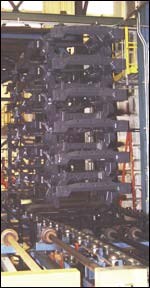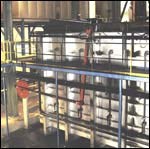Building an E-coat Line from the Ground Up
How one company is prospering by providing flexible e-coat capability to Nissan and other customers.
Analysts may disagree on the precise number of ancillary jobs created by each job at an automaker, but there’s no doubt that employment opportunities at parts suppliers and other service companies are multiplied many times.
Case in point: Madison, MS. Starting in 2001, a swath of the central Mississippi town located about 15 miles north of the state capital of Jackson was transformed into a large industrial park. The new industries sprouted up to serve a new Nissan assembly plant that came on-line in mid-2003. The 3.5-million-sq-ft facility today churns out Nissan Titan pickups, Armada SUVs, Altimas, and Quest minivans, plus Infiniti QX56 SUVs, at the rate of 250,000 vehicles per year.
One of the first new businesses that sprung up in response to Nissan’s presence was Systems Electro Coating (SEC). Housed in a 98,000-sq-ft facility 2-1/2 miles from Nissan, the company operates an electrocoat line that’s notable for both its size and flexibility.
“In July 2001, we began thinking about a site and an e-coat system,” recalls COO Mike McGuffie. “By September, we were talking to potential system suppliers. We developed specs with (joint venture partner) PPG Industries and Nissan, and we put it out to bid with every major e-coat systems developer around.
“Cost is always important—it was a major factor,” he continues. “But we went to several plants and looked at systems. We looked at reliability and flexibility. We interviewed and reviewed quotes from seven potential suppliers and chose George Koch Sons, LLC.”
System Specs
The self-contained line uses a water-based chemistry supplied and maintained by PPG, which maintains an employee on-site. The line uses 14, 23,000-gal tanks; the e-coat tank holds 32,000 gal. Including ovens, the line encompasses 79,000 sq ft. Processing time, from the time a pallet is placed in stage 1 until it comes out of the last e-coat rinse tank, is about one hour.
The process starts with two caustic cleaning stages that run at 130°. These are followed by two rinses, zinc phosphate coating, a sealer, another two rinses, and e-coat. The zinc phosphate dip runs at 120°; the e-coat tank is cooled by chiller and runs at about 92° with 19% solids.
Programmable rectifiers and 32 anodes in the e-coat tank enable consistent film build regardless of the size of the load on the pallet. “It doesn’t matter whether we’ve got 300 sq ft or 1,300 sq ft, processing time remains the same, but we control the voltage in the range it needs to be in,” McGuffie explains.
The e-coat tank also uses a large external cam mechanism that moves pallets of parts during the e-coat process. The side-to-side rocking movement further improves film build consistency, according to McGuffie.
Filters near the end of the line separate the solvent water from the paint. Paint goes back into the e-coat tank, and the water goes back into a rinse tank. The system provides a clean spray and helps control bath conductivity.
The closed-loop system requires paint additions and occasional addition of process water to maintain levels subject to evaporation and fall-out. All additions to the system are made automatically based on analyses of the various tanks. “Since we started, we’ve actually lowered our chemical costs by almost 14% per square foot while maintaining the consistency of our film build,” McGuffie says.
Wastewater treatment is simplified by the system’s water-based chemistry. “We have one floor drain in the whole building, and that goes to wastewater treatment,” McGuffie says. “Wastewater is pH controlled and clarified. We are actually discharging at a rate that is 30% lower than our permit limit.”
Pallets and Cranes
Regardless of size, parts run through the e-coat process on pallets that carry various types of racks. “The common factor in our system is a pallet,” McGuffie explains. “So we develop racks that fit our pallet and the parts.”
Pallets are transferred through the system via one of four overhead cranes—another feature that sets this e-coat setup apart from many. The cranes can tilt pallets over each tank to minimize dragout.
“With the crane system we have, the system can handle 8.08 pallets/hour,” McGuffie says. “We don’t care whether it’s an antique car body, frames, or drill bits on there; we run about 10,000 sq ft/hr of coatable product through the system. We’re running about 95.7% efficiency through the line, and there are weeks and months when we’ve run more than 100%. Automation enables us to hold our costs down and utilize the system efficiently.”
Pallet carriers rotate through the system. Separate carriers are dedicated to the wash/phosphate process and e-coating. As a carrier is emptied it comes back to the front of the system and the next pallet is loaded.
Nissan plans to add a couple more models to its Mississippi production. When that happens, SEC will respond by adding cranes. “Right now, we’re at about 65% of capacity,” McGuffie says. “Plans are to increase capacity by 42%. The system, the ovens, and wastewater treatment system are all sized to handle the additional work. All we’ll need is two more cranes to be able to go from 8.08 pallets/min to 11.5 pallets/min.”
Auto Frames Versus Snack Chips
McGuffie’s background might be considered a bit unusual for his current line of work: he spent 25 years at Frito-Lay, working his way up to manager of the company’s Jackson plant. But he claims there’s no essential difference between running a system for chipping potatoes and one for dipping auto parts. “The raw materials are a little different, but you’re managing the manufacturing system the same way.”
Raw materials for the e-coat system include six types of frames for all the trucks and SUVs Nissan produces up the road. “Nissan wanted to e-coat frames away from their production line and deliver them in a just-in-time environment,” McGuffie says. “They had never done that before. So not only is our system unique, but also the process of delivering frames to the plant 2-1/2 miles away is unique.”
The frame coating process begins when six identical frames are delivered on a pallet from frame manufacturer Tower Automotive, which is contiguous to the SEC plant. A pallet is delivered about every 7-1/2 minutes, the six frames are scanned and entered into SEC’s in-house inventory system, and the pallet is staged to await e-coating.
Nominal film thickness for frames is 0.97 mil, with a normal range from 0.79 to 1.01 mils. According to McGuffie, the e-coat tank’s multiple anodes enable consistent film build even in nooks and crannies on parts. “We periodically take some frames and cut them open to check the film build on the inside,” he says. “We’re getting almost the exact film build on the inside surfaces as we are on the outside.”
After the e-coat process, frames go into the oven for 60 minutes at 380°, through a cooling tunnel, and out into one of six designated inventory lanes. They’re picked one at a time according to Nissan’s requirements, loaded onto specially designed trucks that can handle 20 frames, and shipped to Nissan on a just-in-time basis.
Nissan broadcasts a signal every 30 to 90 seconds that tells SEC what model and variant they plan to assemble next. “From the time we get that broadcast, Nissan will expect that frame to be on their system within about 90 minutes,” McGuffie says. “So, as we accumulate 20 of those broadcasts, we develop a truckload of frames that we send up there based on the order that Nissan will use the frames.”
SEC developed its own system to decode Nissan’s numbers and convert them to a usable format. As frames are picked, the system ties Tower Automotive’s serial number to the vehicle’s VIN number, so for tracking purposes the frame is tied to the vehicle before it’s even built.
Other Components
According to SEC president Toni Cooley, Nissan remains by far the company’s largest customer. “While we run production and service parts for Nissan, we also have several other customers in the Southeast. We e-coat drill bits for Milwaukee Tool, and iron fence posts and finials for another local company. We’re also a Tier 2 for Mercedes in Alabama; we do e-coating for one of their key suppliers based in Tuscaloosa, AL.”
“We’ve kind of grown into these other businesses,” McGuffie confirms. “And we can do that because the e-coat line has the flexibility to let us do it. We can handle everything from car and truck frames—18 ft long, 5-1/2 ft wide, and we do six of those at a time, so the envelope is 11 ft high—down to a drill bit 1-1/2 inches in diameter. We do about 4,000 of those at a time.”
SEC even e-coats entire car bodies--a capability that previously didn’t exist outside of automotive OEMs. “There’s a company here in town that strips the bodies of classic cars to bare metal, then we bring them up here for e-coating,” McGuffie explains. “At Nissan, they do that 60 or 70 times an hour. But for these classic cars, there aren’t many systems large enough to e-coat a whole car body, and that’s something that restorers are looking for. If you’re going to put that much money into a car, you want to make sure it’s not going to rust a few years down the road.”
Related Content
TTX’s Automated Conveyor Carrier System Offers Wireless, Flexible Operation
ACC system designed for reliable, consistent point-to-point movement of everything from small to heavy parts.
Read MoreCoatings Plant Evolves with Market Trends
Expanding its focus from exclusively serving the RV industry, one of this company’s stand-alone coatings plant has successfully extended its services to additional markets.
Read MoreAn Altruistic Growth Strategy Puts People First
Professional Plating emphasizes investing in its team and fostering a supportive environment on the shop floor.
Read MoreMasking Solutions Provider CFS Dramatically Expands Capabilities and Capacity
Custom Fabrication & Supplies (CFS) completed a new plant expansion packing 10 times the capacity into twice the space. It dramatically enhances the supplier’s custom capabilities to provide extremely precise and cost-effective masking solutions.
Read MoreRead Next
Education Bringing Cleaning to Machining
Debuting new speakers and cleaning technology content during this half-day workshop co-located with IMTS 2024.
Read MoreEpisode 45: An Interview with Chandler Mancuso, MacDermid Envio Solutions
Chandler Mancuso, technical director with MacDermid Envio discusses updating your wastewater treatment system and implementing materials recycling solutions to increase efficiencies, control costs and reduce environmental impact.
Read MoreA ‘Clean’ Agenda Offers Unique Presentations in Chicago
The 2024 Parts Cleaning Conference, co-located with the International Manufacturing Technology Show, includes presentations by several speakers who are new to the conference and topics that have not been covered in past editions of this event.
Read More
















.jpg;maxWidth=300;quality=90)








